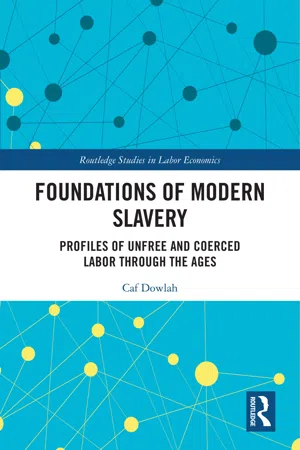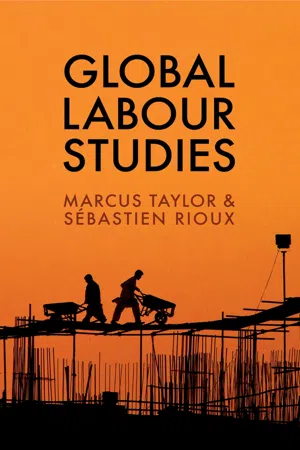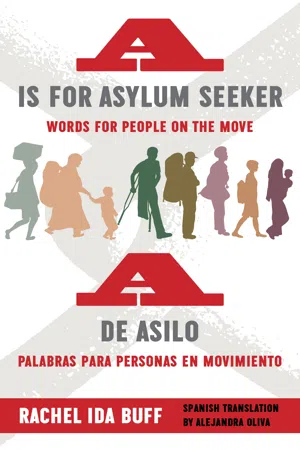Geography
Guest Workers
Guest workers are individuals who are employed in a country other than their own on a temporary basis. They typically work in low-skilled or seasonal jobs, often in industries such as agriculture, construction, or hospitality. Guest worker programs are designed to address labor shortages and provide a source of temporary labor for specific industries within a country.
Written by Perlego with AI-assistance
5 Key excerpts on "Guest Workers"
Learn about this page
Index pages curate the most relevant extracts from our library of academic textbooks. They’ve been created using an in-house natural language model (NLM), each adding context and meaning to key research topics.
- eBook - ePub
Foundations of Modern Slavery
Profiles of Unfree and Coerced Labor Through the Ages
- Caf Dowlah(Author)
- 2021(Publication Date)
- Routledge(Publisher)
Developed country employers also loved a sustained flow of cheap and motivated foreign workers as they unfailingly filled positions in sectors in which native workers were unwilling to work, and dependence on market forces alone would have forced them to raise wages due to chronic shortage of domestic labor. The guestworker programs also enabled them to avoid or delay investments in new and advanced technology, and to employ foreign labor without major adjustments to wages and working conditions, and thus, boost their profits and reduce their costs of production (Mandeel 2014).Guestworker programs also bestowed the best of the world to the governments of developed countries. As temporary foreign workers could be recruited during the periods of economic expansion and released during the periods of economic downswing, labor-importing countries could use them as a buffer to protect native workers in times of recessions. Guestworker programs also allowed labor-importing countries to reap the benefits of lower consumer prices and higher rates of economic growth, export unemployment during periods of recession, and shift the costs to other nations (Massey and Liang 1989).Guestworker programs however had not been equally beneficial for all segments of the society. As such programs are usually pushed by interest-based immigration policy, they essentially resulted in concentrated benefits and diffused costs for the society. By importing temporary foreign workers for a certain sector, the state awarded benefits to that sectors, while the rest of the economy took the brunt. For example, in the US, farmers succeeded in importing guestworkers from Mexico in the 1940s through the 1960s, such imports obviously benefited farmers, but whether that also served the national interest remains an open question (Freeman 1995; Kessler 2001).For labor-surplus developing countries, labor exports provide a cushion against overpopulation, lack of employment opportunities, political instability, and lawlessness. On top of that, they gain workers’ remittances which help them in their balance of payments. Exporting labor also helps them in terms of fusion of knowledge and skill by repatriated migrants, often dubbed as ‘brain gain,’ which contributes to transfer of technology, accumulation of capital, and economic growth (Basu 2016; Bhagwati 1979). For millions of poverty-stricken workers in developing countries employment in developed countries provide a much higher source of income than in domestic economics. The incomes of Mexican Braceros in the United States, and South European and Mediterranean workers in Western European countries had indeed been many times higher than in their domestic economies (Dowlah 2012; Durant et al. 2000). - eBook - ePub
Global Migration
Patterns, processes, and politics
- Elizabeth Mavroudi, Caroline Nagel(Authors)
- 2016(Publication Date)
- Routledge(Publisher)
Insofar as we observe some general patterns of migrant labour market participation that transcend historical-geographical context—e.g. migrants from relatively poor societies tend to cluster in low-waged, low-skilled occupations in relatively wealthy societies—our aim should be to interrogate, rather than take for granted, the diverse processes that generate these patterns. What particular purpose do migrant workers serve in labour markets? On what terms do migrants participate in the workforce of destination societies? What kinds of jobs are, or are not, available to them? And what are the mechanisms through which they are included and excluded in particular occupations and sectors? In addressing these questions, we try to strike a balance between recognizing migrants’ individual and collective agency in the labour market and the constraints on migrant agency posed by occupational hierarchies and racial and gender stereotypes that operate both in sending and receiving societies. On the one hand, we account for migrants’ ability to weigh the costs and benefits of seeking employment abroad, their efforts to secure work that is commensurate with their skill levels and training, and their ability to mobilize social networks to ease their integration into labour markets. On the other hand, we consider the role of employers’ expectations, state practices, and societal norms in structuring migrant participation in economies. Migrants, we emphasize, are not homogenous but rather are differently positioned in hierarchies of class, race, gender, nationality, and legal status; moreover, they enter labour markets that are highly segmented in terms of sector, skills, and social status. It is therefore imperative to explain the generally subordinate position of migrant workers in destination societies while considering the diversity of migrant work experiences in destination societies.Matching workers to jobs: skills, education, and qualifications
An understanding of the role and position of migrant workers in the economies of receiving societies begins with an understanding of the complexities of occupational categories and hierarchies and the diverse social processes that match workers to jobs. All economies consist of multiple sectors of economic activity, including manufacturing, resource extraction, agriculture and forestry, medicine and healthcare, banking and finance, hotels and entertainment, and the like. Within each of these sectors are multiple occupational categories that require different levels of education, skill, and experience. These occupational categories (e.g. administrative staff, accountant, manager, machinist, technician) operate within and across industrial sectors and individual firms. When workers enter the labour market, they choose, and are chosen by, employers for positions based on their qualifications, skills, training, and educational level. One generally does not find unskilled labourers in the upper echelons of investment banking firms, just as one would not expect to find a highly trained surgeon working behind the counter at a fast food restaurant. We therefore start our discussion of migrant participation in labour markets by considering the matching up of individuals’ human capital to occupations.Economists in the early 1960s advocated the term ‘human capital’ as a means of recognizing the differentiation of workers by skill and educational levels. Such differentiation had rarely been recognized—at least explicitly—by traditional economic theories. Human capital refers to an individual’s ‘stock of marketable skills and abilities’ (Borjas, 1999 - eBook - ePub
- Gillian Brock(Author)
- 2021(Publication Date)
- Polity(Publisher)
7Fair Treatment for Temporary Migrant WorkersBy far the greatest number of people who migrate do so on a temporary basis. As one example, consider how in the United States temporary admissions, which include foreign students, diplomats, and tourists, made up more than 181 million admissions in 2015 (Baugh and Witsman 2017). In that same year, the United States granted 2,306,962 permissions for temporary work in sectors such as agriculture, hospitality, and specialty occupations. That is more than double the 1,051,031 permanent residence visas granted in the same year (Department of Homeland Security 2016).Most migration is temporary and most of the temporary migration that occurs is for work purposes. The scale of such movement is vast, and some regions of the world are highly dependent on large temporary workforces. For instance, 164 million of the 258 million international migrants in 2017 were migrant workers (ILO 2017). In many countries, migrant workers are especially prolific in sectors such as construction, agriculture, and care work, where there appear to be domestic shortages, at least at the wage rates prevalent in those sectors. Migrant workers can add considerable economic value to a destination country and some countries can be particularly dependent on a large population of migrant workers in order to get necessary jobs done. In several Middle Eastern countries, migrant workers make up more than 50% of the labor force, such as in the United Arab Emirates, Saudi Arabia, and Qatar.The migrants themselves frequently welcome such opportunities as much-valued employment, especially in home countries with large unemployment or underemployment problems. In developing countries this can be particularly acute; at least 76% of people in developing countries were classified as being in vulnerable employment in 2018 (ILO 2018). Global unemployment in 2019 was estimated at about 193.3 million people (ILO 2018). Many migrants who pursue temporary work opportunities have no desire to settle away from home countries and view these rather as good opportunities to earn comparatively high wages, remit funds to family, and save enough to be able to invest in opportunities back in the home countries or secure a reasonable retirement. - eBook - ePub
- Marcus Taylor, Sébastien Rioux(Authors)
- 2017(Publication Date)
- Polity(Publisher)
Chapter 8 Migrant LabourLabour moves! Both historically and in the present, large-scale movements of people have rewritten the human tapestry of the global economy, giving dynamism to new structures of production and consumption and reshaping livelihoods on a global scale. From economic migrants seeking a better life and greater economic opportunities to temporary migrant workers looking to contribute financially to their household through remittances, the relentless movement of people in search of work remains a defining feature of the contemporary age. In both sending and receiving countries, migratory flows transform labour market dynamics, economic structures and development trajectories. At times, the act of migration appears to open significant opportunities as migrants relocate to spaces where job opportunities may be more plentiful or better paid. Yet most migratory experiences are full of uncertainty and risks. While some workers migrate by choice in the deliberate pursuit of opportunity, many more are extremely reluctant to leave established homes, family and friends, all of which provide a degree of stability and security. As a result, the urge to migrate is often situated in the middle ground between a drive to take advantage of new opportunities and as a reaction to coercive socioeconomic constraints.To understand this complexity, our focus on power, networks, space and livelihoods provides useful tools to help us unpack the forces that shape migrant trajectories. They provide ways to open up questions of why some migratory experiences offer opportunities, while others create new forms of precarious labour. Such unevenness, as we chart below, is driven in part by the complexity of how households plan their livelihood strategies by using social networks to provide much needed resources, information and assistance to facilitate migratory patterns. Alongside this emphasis on migrant agency, however, we cannot ignore the bigger picture of strong structural constraints upon migrant trajectories. While labour moves, migration typically remains heavily controlled. States strongly limit the movement of people across borders and often have elaborate criteria for distinguishing between wanted and unwanted migrants based on skills, training, wealth and country of origin. Such migration controls, therefore, typically reinforce the creation of segmented labour markets and the production of specific migrant labour regimes in receiving regions. As we explain below, this means that different strata of migrants experience very different outcomes, and that migratory flows remain deeply rooted within the power relations constitutive of the global economy. - eBook - ePub
- Rachel Ida Buff, Alejandra Oliva(Authors)
- 2020(Publication Date)
- Fordham University Press(Publisher)
After World War II, West Germany recruited Guest Workers or “gastarbeiters” from Turkey. Like braceros in the United States, these workers made important contributions to the West German economy, rebuilding and modernizing industrial production. After 2005, a law passed allowing Guest Workers in Germany to naturalize, although because the German constitution does not allow dual citizenship, those choosing to become German citizens lose citizenship in their countries of origin. Of the roughly 2.5 million Germans of Turkish nationalist or parentage, about 700,000 are German citizens.While the United Arab Emirates (UAE) employs only a small percentage of the global population of Guest Workers compared to Germany and the United States, these workers make up close to 90 percent of the nation’s population. Introduced in 1971, a kafala system monitors Guest Workers in the Gulf States. Many of these workers are from Bangladesh, India, Pakistan, the Philippines, and Somalia. But these workers have few rights. UAE citizenship, which protects civil rights as well as allowing property ownership in the country, is limited to children of Emirati citizens.In the United States, escalating numbers of Guest Workers labor in low wage agriculture and service as well as hightech fields. Guest worker programs are often promoted as more politically palatable than immigration, because they allow for only short-term stays in the country.A global regime of xenophobia and immigration restriction constrains the rights of people on the move. But the economies of the global north continue to need workers. While guest worker programs offer a partial fix for this contradiction, the lack of rights they convey ensures ongoing abuses of labor and civil rights.See also: Undocumented, VisaTrabajador InvitadoPuruándiro, Michoacán, México – 1998:




